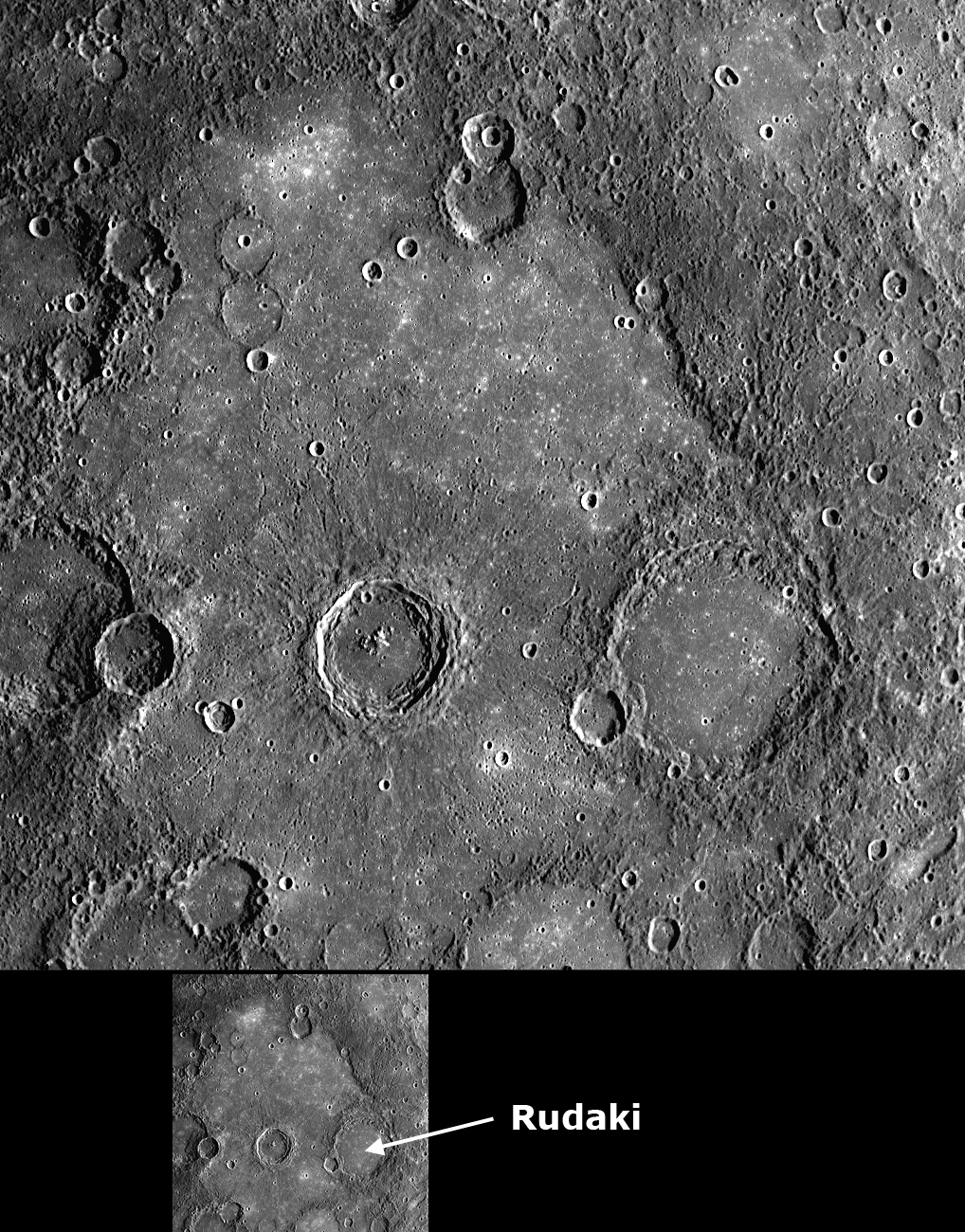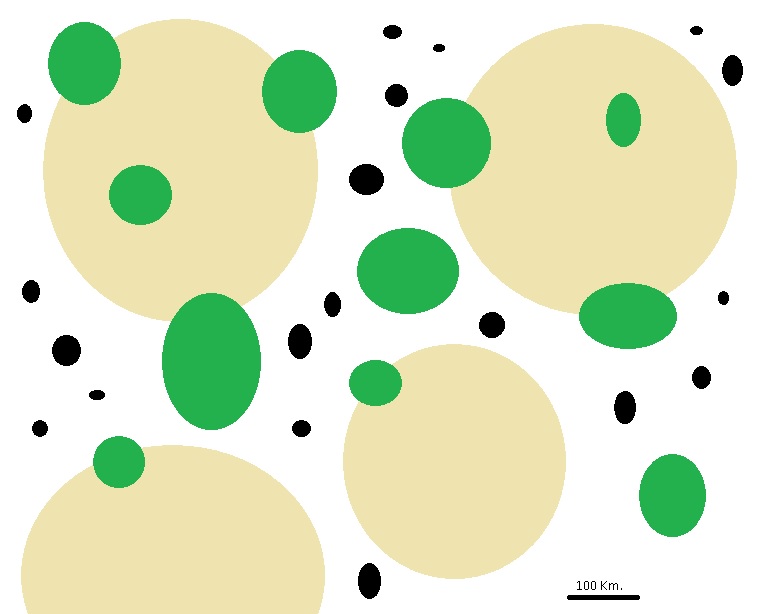Intercrater Plains On Mercury on:
[Wikipedia]
[Google]
[Amazon]
Inter-crater plains on Mercury are a land-form consisting of
 There are two geologically distinct types of plains on Mercury - smooth plains of volcanic origin, and, inter-crater plains, of uncertain origin.
There are two geologically distinct types of plains on Mercury - smooth plains of volcanic origin, and, inter-crater plains, of uncertain origin.
 The most heavily cratered regions on Mercury contain large areas essentially free of impact craters with diameters greater than 50 kilometers. The surface areas of these regions can basically be divided into two categories: clusters of large craters and plains bordering these clusters of craters. This combination of surface features has been called "inter-crater plains" by the ''Mariner 10'' Imaging Science Team. These plains have sparked debate.
The most heavily cratered regions on Mercury contain large areas essentially free of impact craters with diameters greater than 50 kilometers. The surface areas of these regions can basically be divided into two categories: clusters of large craters and plains bordering these clusters of craters. This combination of surface features has been called "inter-crater plains" by the ''Mariner 10'' Imaging Science Team. These plains have sparked debate.
 Unlike smooth plains, the origin of inter-crater plains has yet to be well determined. Research and studies have narrowed the origin of inter-crater plains on Mercury down to two hypotheses. The first hypotheses attributes formation from fluidized impact,
Unlike smooth plains, the origin of inter-crater plains has yet to be well determined. Research and studies have narrowed the origin of inter-crater plains on Mercury down to two hypotheses. The first hypotheses attributes formation from fluidized impact,
plain
In geography, a plain is a flat expanse of land that generally does not change much in elevation, and is primarily treeless. Plains occur as lowlands along valleys or at the base of mountains, as coastal plains, and as plateaus or uplands ...
s between crater
Crater may refer to:
Landforms
*Impact crater, a depression caused by two celestial bodies impacting each other, such as a meteorite hitting a planet
*Explosion crater, a hole formed in the ground produced by an explosion near or below the surfac ...
s on Mercury
Mercury commonly refers to:
* Mercury (planet), the nearest planet to the Sun
* Mercury (element), a metallic chemical element with the symbol Hg
* Mercury (mythology), a Roman god
Mercury or The Mercury may also refer to:
Companies
* Merc ...
.
Of the eight planet
A planet is a large, rounded astronomical body that is neither a star nor its remnant. The best available theory of planet formation is the nebular hypothesis, which posits that an interstellar cloud collapses out of a nebula to create a you ...
s in the Solar System
The Solar SystemCapitalization of the name varies. The International Astronomical Union, the authoritative body regarding astronomical nomenclature, specifies capitalizing the names of all individual astronomical objects but uses mixed "Solar S ...
, Mercury
Mercury commonly refers to:
* Mercury (planet), the nearest planet to the Sun
* Mercury (element), a metallic chemical element with the symbol Hg
* Mercury (mythology), a Roman god
Mercury or The Mercury may also refer to:
Companies
* Merc ...
is the smallest and closest to the Sun. The surface of this planet is similar to the Moon
The Moon is Earth's only natural satellite. It is the fifth largest satellite in the Solar System and the largest and most massive relative to its parent planet, with a diameter about one-quarter that of Earth (comparable to the width of ...
in that it shows characteristics of heavy cratering and plains formed through volcanic eruption
Several types of volcanic eruptions—during which lava, tephra (ash, lapilli, volcanic bombs and volcanic blocks), and assorted gases are expelled from a volcanic vent or fissure—have been distinguished by volcanologists. These are often ...
s on the surface. These features indicate that Mercury has been geologically inactive for billions of years. Knowledge of Mercury's geology was initially quite limited because observations have only been through the ''Mariner 10
''Mariner 10'' was an American Robotic spacecraft, robotic space probe launched by NASA on 3 November 1973, to fly by the planets Mercury (planet), Mercury and Venus. It was the first spacecraft to perform flybys of multiple planets.
''Ma ...
'' flyby in 1975 and observations from Earth
Earth is the third planet from the Sun and the only astronomical object known to harbor life. While large volumes of water can be found throughout the Solar System, only Earth sustains liquid surface water. About 71% of Earth's surfa ...
. The ''MESSENGER
''MESSENGER'' was a NASA robotic space probe that orbited the planet Mercury between 2011 and 2015, studying Mercury's chemical composition, geology, and magnetic field. The name is a backronym for "Mercury Surface, Space Environment, Geoche ...
'' (an acronym of MErcury Surface, Space ENvironment, GEochemistry, and Ranging) mission of 2004 was a robotic NASA
The National Aeronautics and Space Administration (NASA ) is an independent agency of the US federal government responsible for the civil space program, aeronautics research, and space research.
NASA was established in 1958, succeeding t ...
spacecraft orbiting the planet, the first spacecraft ever to do so. The data provided by ''MESSENGER'' has revealed a geologically complex planet.
Types of plains
 There are two geologically distinct types of plains on Mercury - smooth plains of volcanic origin, and, inter-crater plains, of uncertain origin.
There are two geologically distinct types of plains on Mercury - smooth plains of volcanic origin, and, inter-crater plains, of uncertain origin.
Smooth plains
Smooth plains are widespread flat areas resembling the lunar maria of the Moon, which fill depressions of various sizes. A prime example of a smooth plain is the one in which fills a wide ring surrounding the Caloris Basin, the largest impact basin on Mercury. However, a noticeable difference between the lunar maria of the Moon and the smooth plains of Mercury is that these smooth plains have the samealbedo
Albedo (; ) is the measure of the diffuse reflection of sunlight, solar radiation out of the total solar radiation and measured on a scale from 0, corresponding to a black body that absorbs all incident radiation, to 1, corresponding to a body ...
, or properties, as the bordering inter-crater plains. Even with a lack of volcanic features, it is still believed that smooth plains are of volcanic origin.
Inter-crater plains
Inter-crater plains are the oldest visible surface on Mercury, predating the heavily cratered terrain. They are gently rolling or hilly plains and occur in the regions between larger craters. The inter-crater plains appear to have covered up or destroyed many earlier craters, and show a general scarcity of smaller craters below about 30 km in diameter. It is not clear whether they are of volcanic or impact origin. The inter-crater plains are distributed roughly uniformly over the entire surface of the planet. The most heavily cratered regions on Mercury contain large areas essentially free of impact craters with diameters greater than 50 kilometers. The surface areas of these regions can basically be divided into two categories: clusters of large craters and plains bordering these clusters of craters. This combination of surface features has been called "inter-crater plains" by the ''Mariner 10'' Imaging Science Team. These plains have sparked debate.
The most heavily cratered regions on Mercury contain large areas essentially free of impact craters with diameters greater than 50 kilometers. The surface areas of these regions can basically be divided into two categories: clusters of large craters and plains bordering these clusters of craters. This combination of surface features has been called "inter-crater plains" by the ''Mariner 10'' Imaging Science Team. These plains have sparked debate.
Origin hypotheses
 Unlike smooth plains, the origin of inter-crater plains has yet to be well determined. Research and studies have narrowed the origin of inter-crater plains on Mercury down to two hypotheses. The first hypotheses attributes formation from fluidized impact,
Unlike smooth plains, the origin of inter-crater plains has yet to be well determined. Research and studies have narrowed the origin of inter-crater plains on Mercury down to two hypotheses. The first hypotheses attributes formation from fluidized impact, ejecta
Ejecta (from the Latin: "things thrown out", singular ejectum) are particles ejected from an area. In volcanology, in particular, the term refers to particles including pyroclastic materials (tephra) that came out of a volcanic explosion and magma ...
, which is the result of a meteorite impacting the surface so hard that it turns to liquid, then liquid debris is ejected into the air and lands, filling in any lower elevation areas or craters. The other hypothesis is that the plains formed from volcanic deposits originating from below the surface of Mercury itself.
On the basis of the distribution of inter-crater plains and stratigraphic relationships between secondary craters and smooth plains it is argued that the majority of the inter-crater plains were emplaced volcanically.
''MESSENGER'' data
Information and data were gathered from ''Mariner 10''stereoscopic
Stereoscopy (also called stereoscopics, or stereo imaging) is a technique for creating or enhancing the depth perception, illusion of depth in an image by means of stereopsis for binocular vision. The word ''stereoscopy'' derives . Any stere ...
images and higher resolution ''MESSENGER
''MESSENGER'' was a NASA robotic space probe that orbited the planet Mercury between 2011 and 2015, studying Mercury's chemical composition, geology, and magnetic field. The name is a backronym for "Mercury Surface, Space Environment, Geoche ...
'' datasets. The higher resolution of the ''MESSENGER'' datasets compared with those of ''Mariner 10'' enables the most ancient plains units on Mercury to be better characterized. The inter-crater plains units are densely cratered at diameters under ten km, producing a highly textured surface that yields ancient pre-Tolstojan
Pre-Tolstojan, also Pretolstojan Period, refers to the oldest period of the history of Mercury, 4500–3900 MYA. It is the "first period of the Eomercurian Era and of the Mercurian Eon, as well as being the first period in Mercury's geologic h ...
and Tolstojan ages over 3.9 Ga (billion years). There is no clear correlation with topography; inter-crater plains cover high-standing plateaus and continue into topographic depressions. These results show that either the formation process must have been able to take place over a range of several kilometers supporting an impact-related origin, or that plains are generally flat lying areas which become uplifted, lowered, or tilted after formation.
References
{{Mercury (planet) Mercury (planet)